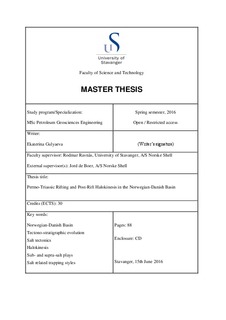| dc.contributor.advisor | Ravnås, Rodmar | |
| dc.contributor.author | Gulyaeva, Ekaterina | |
| dc.date.accessioned | 2016-10-12T14:40:30Z | |
| dc.date.available | 2016-10-12T14:40:30Z | |
| dc.date.issued | 2016-06-15 | |
| dc.identifier.uri | http://hdl.handle.net/11250/2414786 | |
| dc.description | Master's thesis in Petroleum geosciences engineering | nb_NO |
| dc.description.abstract | The area of investigation is located in the Norwegian sector of the Norwegian-Danish Basin (NDB) and covers an area of ~20,000 km2 between the Stavanger Platform and the Central Graben. This basin is a Late Permian rift-basin, where the Upper Permian evaporite-dominated Zechstein Group was accumulated, followed by the deposition of a thick package of Triassic continental strata. The presence of an extensive and thick salt unit within the NDB has significantly influenced patterns of post-salt sedimentation and tectonics in the area during the Mesozoic to the Cenozoic. Furthermore, halokinetic movements control the distribution and geometry of reservoirs, various structural styles, and trapping mechanisms.
The Norwegian part of the NDB is relatively unexplored primarily due to perceive of working petroleum system, and is related to the little understood trapping configurations and uncertain reservoir distribution. In this study, 2D and 3D seismic surveys, well data and analogues are used to map and investigate the tectono-stratigraphic evolution of the NDB from the Late Permian to the Triassic with emphasis given to salt tectonics and its impact on distribution and characteristics of sub- and supra-salt play potential.
The post-Hercynian structural evolution of the NDB commenced with the formation of interior sag basins in the Middle-Late Permian. Subsequently, East-West extension took place in the Late Permian, producing sub-salt faults and tectonic domains. The Triassic halokinetic movements were a response to differential loading and reactivation of sub-salt normal faults, which in turn resulted in pod-intrapod structural styles and sedimentary architecture.
Halokinesis is a principal mechanism within the NDB controlling generation and distribution of the main elements that comprise plays and petroleum systems. For the sub-salt play potential, salt acts as a regional impermeable caprock. For supra-salt plays, halokinetic movements control the distribution of reservoirs and a wide range of trap styles, provide seal against the salt structures, and control access to charge from sub-salt source rocks to supra-salt plays through salt windows in areas with grounded Triassic pods. Identified sub-salt Upper Permian, supra-salt Lower and Upper Triassic plays are poorly explored plays with a candidate petroleum system. The plays are widely represented within the NDB and can form viable exploration targets in the future. | nb_NO |
| dc.language.iso | eng | nb_NO |
| dc.publisher | University of Stavanger, Norway | nb_NO |
| dc.relation.ispartofseries | Masteroppgave/UIS-TN-IPT/2016; | |
| dc.rights | Navngivelse 3.0 Norge | * |
| dc.rights.uri | http://creativecommons.org/licenses/by/3.0/no/ | * |
| dc.subject | petroleumsteknologi | nb_NO |
| dc.subject | petroleumsgeologi | nb_NO |
| dc.subject | petroleum geosciences engineering | nb_NO |
| dc.subject | tectono-stratigraphic evolution | nb_NO |
| dc.subject | halokinesis | nb_NO |
| dc.title | Permo-Triassic and Post-Rift Halokinesis in the Norwegian-Danish Basin | nb_NO |
| dc.type | Master thesis | nb_NO |
| dc.subject.nsi | VDP::Technology: 500::Rock and petroleum disciplines: 510::Geological engineering: 513 | nb_NO |

